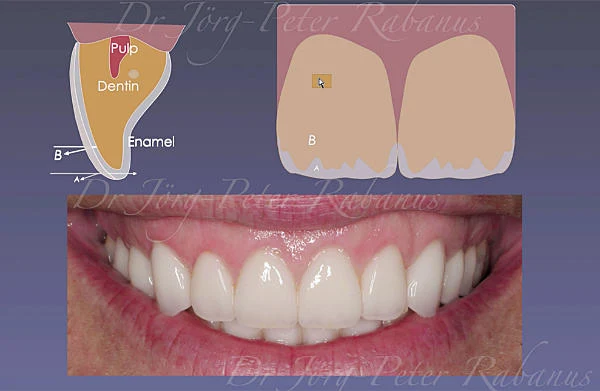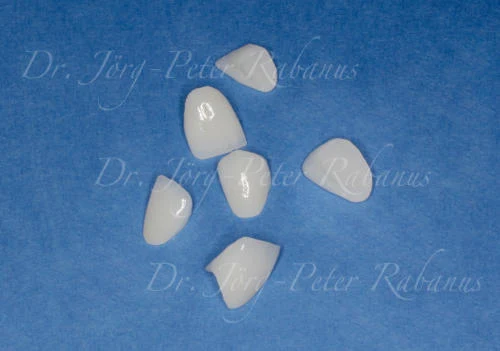Porcelain Veneers in San Francisco


AACD-accredited cosmetic dentist of San Francisco, Dr. Jorg-Peter Rabanus,
explains how dental veneers are designed and what they can do for a variety
of dental conditions.
Dental veneers are fabricated of biocompatible materials, such as porcelains, composite acrylics, or combinations of different porcelains or ceramics.
'Porcelain laminate' is an older term for 'porcelain veneer.' The term 'laminate' comes from the latin word 'lamina' which means 'thin plate' or 'scale.' In the era of minimally invasive dentistry it is only natural to utilize thin laminates of a strong ceramic material to enhance smiles. The definition for the general term "lamination is a uniting of superposed layers of a protective material by an adhesive or other means. This is what we do in cosmetic dentistry.
The best veneers are fabricated in the dental laboratory by specific cutback and layering techniques, which render the most natural, youthful, and playful look of a smile. The times of china-white "Hollywood smiles" are over. It is not desirable to anyone to give away that he or she has a smile makeover. The main reason why patients come to Dr. Rabanus to have old veneers replaced is their unnatural, opaque, and monochromatic appearance, which is even less acceptable due to often missed elementary design requirements that are discussed elsewhere in this website.
The term 'veneer' comes from the german word 'furnier.' Originally, it was a thin sheet of wood adapted for adherence to a smooth surface. Porcelain veneers have principally the same protective and aesthetic function as wood veneers. They are thin layers of high quality materials that are bonded to a smooth understructure. Composite and porcelain dental veneers are the most common procedures offered by cosmetic dentists. They have many applications, such as
- strengthening of weeakened enamel,
- restoration of eroded and worn enamel,
- veneering with a whiter layer of porcelain to mask heavily stained teeth, and
- creating more youthful attributes, by incorporating incisal translucency, harmonic line angles, and the proportions of young teeth.
We will constantly update the information about porcelain materials and the technology that are used for these purposes.
Porcelain veneers are a rapid, aesthetic, and safe way to correct unattractive front teeth. They correct heavy dental stains, teeth that are crooked, disproportionate, relatively small (with spaces), and structurally damaged. As mentioned above, they are shells of ceramic/porcelain material that can be chemically bonded to tooth structure. Dental veneers are the most popular treatment modality for comprehensive smile makeovers.
One of the most significant breakthroughs in dentistry has been the development of new adhesion techniques and cosmetic dental porcelains) that enable the dentist to successfully adhere organic tissues and inorganic materials to each other.
The bonding between a porcelain veneer and the natural tooth surface is very strong if done correctly. It can be so great that an accidental trauma of a veneered tooth may cause a fracture within the tooth structure and not at the interface of porcelain veneer to prepared tooth surface.
Bonded to tooth structure, certain porcelain veneer materials display similar physical properties as natural enamel. In addition, with the advance of ceramic technology, natural layers and youthful translucencies of vital teeth can be perfectly mimicked.
For further information, go to page "Materials and Methods" in the section "Technical Specifications."
Smile makeovers with porcelain veneers often involve just one diagnostic and two treatment visits. The first visit is for diagnosis and dental impressions that are used to create a diagnostic wax-up on study models. During the second visit, the information obtained with the model analysis and the diagnostic wax-up will be used to prepare the teeth. Master impressions of the prepared teeth will be taken. Temporary acrylic veneers are created with acrylic-filled matrices that are molds of the diagnostic wax-up. Hence, the temporary veneers look exactly like the diagnostic wax-up, allowing the patient and the cosmetic dentist to evaluate their appearance and comfort in the patient's mouth. The processing at the dental laboratory usually takes two weeks. The final porcelain veneers are permanently bonded at the last office visit.
How much tooth structure needs to be removed? [Video]
Many dental patients are concerned about the need to shave their teeth to create space for their veneers. Hence, every cosmetic dentist is being asked about the extent of tooth reduction. The answer is not uniform and depends on the clinical situation of the teeth and the goals. This video explains the considerations that have to take place when preparing teeth for porcelain restorations with adherence to minimally invasive dentistry.


